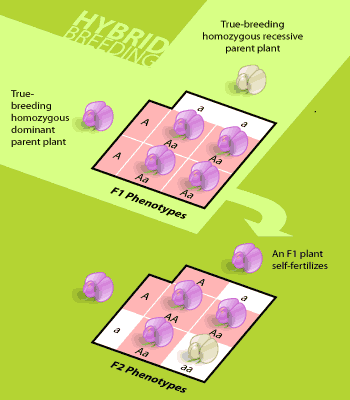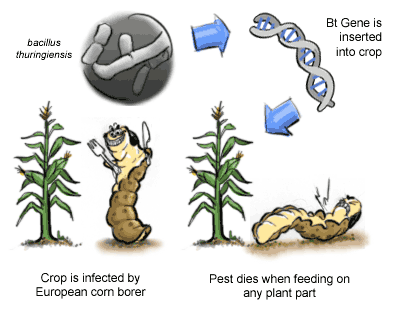PLANT BREEDING VERSUS PLANT GENETICS
(August 2003)
The cultivation of plants is an important aspect of today’s society in many ways. Not only do plants supply us with a major food resource and flow of nutrition but they are also an important source of chemicals and other non-food products such as drugs, oils, latex, pigments, and resins [3]. Because of the high value of plants, farmers are constantly trying to increase the yield and quality of their products by using more effective production techniques.
The physical appearance of plants is determined by genetic factors that are inherited from parental crops. The natural transfer of genes can be altered using many genetic techniques such as selection or genetic engineering. One of the important goals of plant breeding is maintaining genetic diversity. This can be achieved through selection and hybridization. More recently, new techniques have evolved to allow us to grow crops artificially in culture from plant parts to produce whole plants.
Modern science has allowed us to get away from the traditional method of plant breeding to more artificial asexual methods. This allows plants to be produced using individual, or groups of cells, which grow into full plants. Genetics has also allowed us to modify our crops in a more scientific way to select for traits that are more desired by society. In this article we will be discussing the differences between the more traditional techniques of plant breeding and the modern advances of plant genetics.
Plant Breeding
Selection
Plant improvement by man began many thousands of years ago. Pre-agricultural man learned that seeds put into the ground at a certain time of the year produced similar seed-producing plants [5]. This was the beginning of domestication of plants and led to the production of the first crops. Soon after, it was discovered that some crops of the same species grew better or tasted better than others, which became the starting point of selection breeding.
Later in the nineteenth century, Charles Darwin brought to light his theory of Natural Selection, which he described as “survival of the fittest” [5]. It was this statement that showed how selection occurred naturally with the environment selecting which plants would grow in specific parts of the world. Selection by farmers was an extension of this process. Farmers were able to further select for plants that not only grew well, but had better taste and looking more pleasing to the eye. Later, selection was further applied to find crops that produced the highest yield with the best possible quality [4].
In order for one to undergo selection, the breeder must have a large population of seeds to select from. This population should contain several different genetic types that are well adapted to the seasonal changes in the environmental conditions they are grown. These populations are called landraces and are generally found in regions where older plants have been growing for a long time. Natural selection has already occurred leaving only those crops that have been able to adapt to their environment [4]. Landraces are generally found in areas where cross-breeding has been able to occur giving rise to many new genetic varieties with new genotypes constantly being introduced into the environment. Once an appropriate population is found, one can begin the process of selecting plants by removing those plants with undesired traits. This allows plants with the most desired traits to survive and give rise to a new line of crop that has been selectively chosen for its specific traits.
Hybrid Breeding
Another method of selection in plants occurs when two different pure lines are crossed giving rise to what is called a hybrid. Hybrids have the genetic basis of each of the traits of the parents. In this way, one can obtain plants with the genetic basis for many desirable traits exhibited by each of the parents. By further selection of the offspring, one can select for desired traits (Figure 1).

Plant Genetics
Although selection has been fairly effective over the years and is still used in some places today, it has not been able to keep up to the growing need for plants and plant products. Selection takes time and many things have to be considered, especially environmental factors that cannot always be controlled. It is for this reason that new and more effective methods of plant breeding have been discovered to give rise to an increased number of plants over a shorter period of time.
With a basic understanding of how genetics plays a role in determining the appearance and shape, as well as growth responses of a plant, geneticists have been able to further their knowledge and apply new techniques for growing plants. With a foot in the door as to what gives rise to different traits, geneticists were able to take this one step further by modifying the genetics of a certain plant artificially using an asexual technique to grow these plants. This enables plant scientists to select for the traits that were most suitable for the crops they are growing without having to go through the long and tedious procedures of growing the crops and selecting for the traits that are within that population.
New techniques involve growing whole plants from single cells artificially in cultures that contain all the required nutrients and factors involved in cell growth [2]. This technique is referred to as plant cell culture. Furthermore, scientists have been able to clone specific genes from one species and insert them into plants to introduce new traits that may benefit the plant species [1]. This procedure is known as transgenics and gives rise to genetically modified crops. Furthermore, selection was put into operation to find crops that could withstand certain pests and environmental conditions, such as drought or freezing temperatures. An example of this is seen in genetically modified canola containing a gene that allows flounders to live in cold water. This allows the canola to survive in colder weather giving it a month longer growing season [4]. A further example of this is seen in producing crops that are resistant to certain conditions or microorganisms that may cause harm to the plants. This also allows for farmers to reduce the amount of pesticides required in protecting their crops (Figure 2).

New vs. Old
Although plant science is a relatively new field of interest, there has been a great deal of new technology in this field. Plant scientists have been able to overcome the slow reproductive phase involved in growing plants and have been able to produce plants that can grow in half the time with much better results. In order to make up for the growing demand of crops in today’s society, working with geneticists has enabled this to occur. Although old methods of plant breeding are still practiced today in many parts of the world, especially in developing countries, many developed countries have switched to using these new technologies. However, as for anything there are limitations and concerns for both methods.
The more primitive methods of selection take a long time and do not always provide the desired crops. In addition, when a farmer does finally achieve his desired plant product, industry has changed and a new trait is preferred over the previous one. In a constantly growing and changing world, it seems that the farmer can never get ahead. Also, changing environmental conditions can lead to decreased crop yield from year to year and possibly even cause the farmer to lose entire crops. Other disasters, such as fire and disease can lend its destruction to crops causing much devastation.
In the more modern methods of plant growth, crops can be grown in artificial medium requiring less landmass to produce large amounts of crops in less time. Although this seems like a great alternative to the earlier methods, it can also be devastating. By growing plants at a faster rate, we may be losing the essential vitamins and nutrients that are important for us. Incorporating foreign genes has been suggested to lead to allergies in many people as well as affect the food chain of other organisms. Transgenics is still a relatively new field and no concrete evidence for any of this exists but it is growing concern.
Plant science is a growing field that is constantly evolving to promote changes that benefit both the industry and accommodate the growing populations that we are facing. With the many innovative ideas and constant findings, plant science has provided many great additions to society.
References
1. Bajaj Y. (2001). Transgenic Crops. Berlin ; New York : Springer
2. Chawla H. S. (2000). Introduction to Plant Biotechnology. Science Publishers Inc. Enfield, NH, USA.
3. Columbia Encyclopedia, Sixth Edition, Copyright © 2003.
4. Kuckuck H., Kobabe G., Wenzel G. (1991). Fundamentals of plant breeding. Springer-Verlag. New York, USA.
5. Lawrence W. (1968). Plant breeding. Edward Arnold (Publishers) Ltd. London, Great Britain
For More Information
(Art by Jiang Long – note that high res versions of these image files are available here)